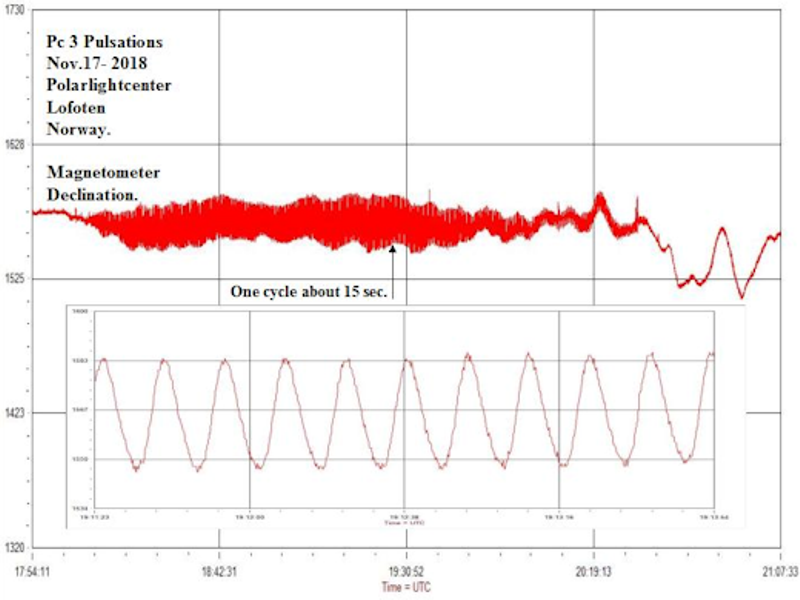This week in Norway, a space weather observatory detected sine waves of exceptional purity rippling through Earth's polar magnetic field. The waves, which persisted for hours with nearly perfect pitch, have been linked to "tearing instabilities" and explosions in Earth's magnetic tail-not to mention bright auroras in Arctic skies.
When a stream of solar wind hits Earth, magnetometers around the Arctic Circle normally
go haywire, their needles swinging chaotically as local magnetic fields react to the buffeting of the solar wind.
On Nov. 18th, however, something quite different happened. Solar wind hit Earth and produced ...
a pure, almost-musical sine wave:

© Rob Stammes / Polarlightcenter
Rob Stammes recorded the event from the Polarlightcenter, a magnetic observatory in the Lofoten Islands of Norway.
"A very stable ~15 second magnetic oscillation commenced and persisted for several hours," he says. "The magnetic field was swinging back and forth by 0.06 degrees, peak to peak,
with the regularity of a metronome."
Imagine blowing across a piece of paper, making it flutter with your breath. The solar wind can have a similar effect on magnetic fields. The waves Stammes recorded are essentially flutters propagating down the flanks of Earth's magnetosphere excited by the breath of the sun. Researchers call them "pulsations continuous" -- or "Pc" for short.
"A very sensitive magnetometer is required to record these delicate waves," says Stammes. "I use a mechanical magnetometer with bar magnets suspended from a special wire. LEDs and light detectors in an isolated dark box record the motion of the magnets, while vanes in oil damp out non-magnetic interference."
Pc waves are classified into
5 types depending on their period. The waves Stammes recorded fall into the range 15 to 45 seconds--that is, Pc3. Researchers have found that Pc3 waves sometimes flow around Earth's magnetic field and cause a "
tearing instability" in our planet's magnetic tail. This, in turn, can set the stage for an explosion as magnetic fields in the tail reconnect.
A quartet of NASA spacecraft recently flew through just such an explosion. Last week, researchers from the University of New Hampshire
reported that four Magnetospheric Multiscale (MMS) spacecraft spent several seconds inside a magnetic reconnection event as they were orbiting through Earth's magnetic tail. Sensors on the spacecraft recorded
jets of high energy particles emerging from the blast site.
One jet was aimed squarely at Earth and probably sparked auroras when it hit the upper atmosphere.
Stammes has recorded many
Pc waves in the past,
"but this is the first time I have detected category Pc3," he says. "This was a very rare episode indeed."

Comment: It's galactic alignment Jim, but not as once prophesied.
Exactly one week before this event, on November 11th, a similarly 'harmonious' seismic event occurred 'in' the Earth, which pulsated for 20 minutes to the beat of a long monochromatic signal with a ~17s period...